Chapter 12: Rights of the Girl Child
Chapter Summary
- The Girl Child
- Profile: Bogaletch Gebre
- Project: Changing Hearts and Minds: Averting Child Marriage in Yemen
- Questions
- Additional Resources
“The girl child” is one of the critical areas of the 1995 Beijing Platform for Action; girls’ rights are codified within the U.N. Convention on the Rights of the Child and include non-discrimination, protection from harm and abuse, and full participation in family, social, and cultural life. Barriers to realizing these rights include practices such as female genital mutilation (FGM), sex-selective abortions, and child marriage, each of which is common in geographically specific areas.
Dr. Bogaletch Gebre founded the organization Kembatti Mentti Gezzimma-Tope (KMG) to support education and economic opportunity for young women in Ethiopia through fundraising, protest, and community-based research. The Yemeni Women’s Union (YWU) focuses on reproductive health and family planning by running education workshops on the harms of child marriage and pregnancy and engages with families on the risks and long-term implications of these practices. The YWU is one of several organizations which work using different approaches, including media campaigns, advocacy, lobbying, and sharing knowledge through network building, to enhance the effectiveness of strategies to improve the situation of girls worldwide.
Key Terms
- Bogaletch Gebre
- Child marriage
- Female genital mutilation (FGM)
- International Ethiopia-Development through Education
- Kembatti Mentti Gezzimma-Tope (KMG)
- Marriage Without Risks Network (MWRN)
- Safe Age of Marriage Project (SAWP)
- United Nations Convention on the Rights of the Child (UNCRC)
- Yemeni Women’s Union (YWU)
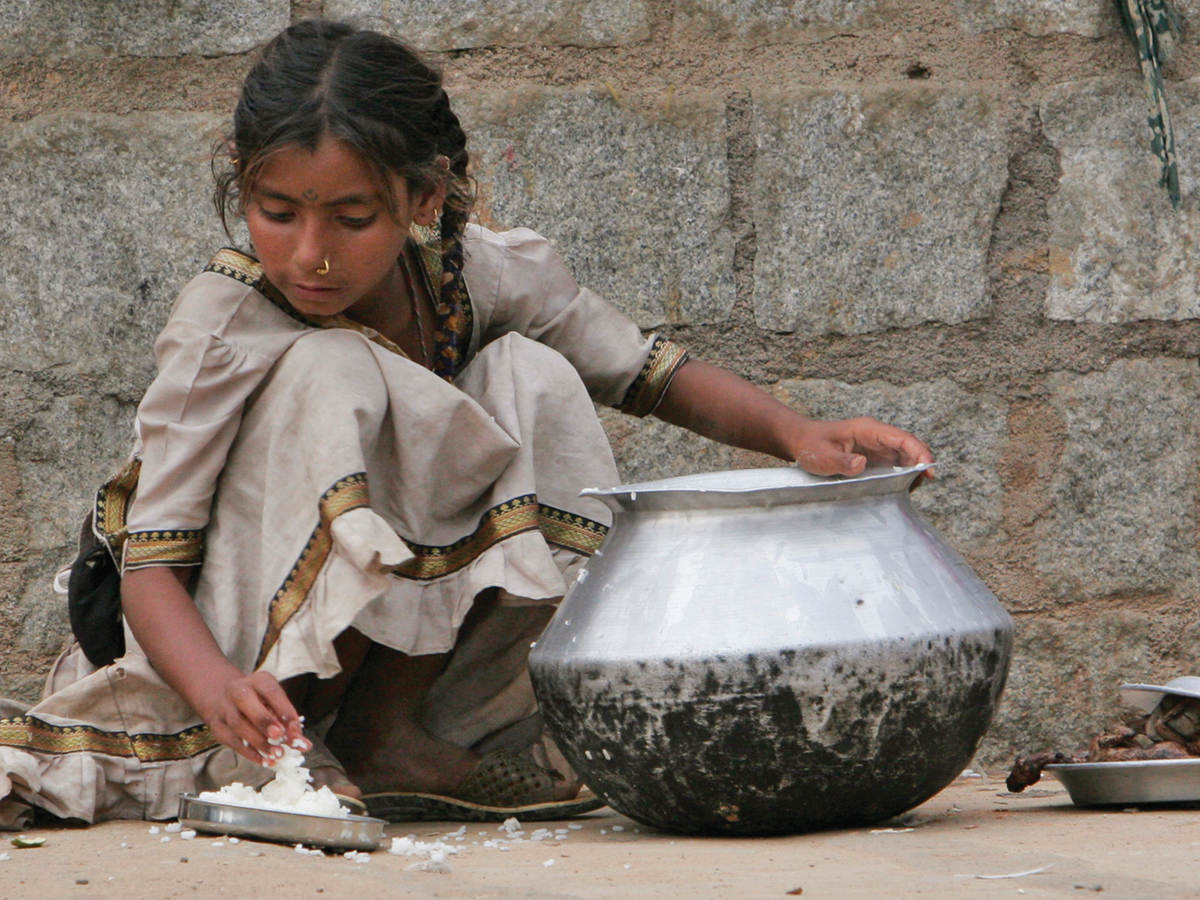
The Girl Child
By Robin N. Haarr
In many cultures and societies, the girl child is denied her human rights and sometimes her basic needs. She is at increased risk of sexual abuse and exploitation and other harmful practices that negatively affect her survival, development and ability to achieve to her fullest potential. Because girls are particularly vulnerable, they require additional protections. The girl child is one of the 12 critical areas in the 1995 Beijing Platform for Action, which recommends elimination of all forms of discrimination and abuse of girls and protection of their rights.
The Convention on the Rights of the Child, adopted by the United Nations General Assembly in 1989, sets forth the basic human rights of children, usually those under 18 years of age. These rights include nondiscrimination; the right to survival and development of potential; protection from harmful influences, abuses and exploitation; and full participation in family, cultural and social life. The convention also spells out some human rights violations that are unique to the girl child, including discrimination based upon sex, prenatal sex selection, female genital mutilation and early marriage.
Cultural Influences on Treatment of Girl Children
Discrimination and harmful practices against the girl child vary depending upon cultural context. For instance, intentional abortion of female fetuses and female infanticide are common practices in East and South Asian countries where sons are strongly preferred. India and China have a significant sex-ratio imbalance in their populations as a result of these practices, according to the United Nations Population Fund (UNFPA, 2005). In India such practices are reinforced by the perception that daughters are an economic burden on the family. They do not significantly contribute to the family income and large dowries may be expected by in-laws when the girl marries. In China, sex selectivity and abandonment of infant girls have increased dramatically since the enactment of the one-child policy in 1989. Prenatal sex selection is more common where modern medical technology is readily accessible and open to misuse. According to the UNFPA 2004 report, sex-selective abortion and female infanticide have resulted in at least 60 million “missing” girls in Asia. The shortage of females in some Asian countries has led to other problems, such as increased trafficking in women for marriage and sex work. Despite government programs and efforts to end such practices with education, financial incentives and threat of punishment, sex-selective abortion and female infanticide continue.
The status of girls is significantly less than that of boys in some countries. This makes girls more vulnerable to discrimination and neglect. Available indicators reveal that girls are discriminated against from the earliest stages of life in the areas of nutrition, health care, education, family care and protection. Girls are often fed less, particularly when there are diminished food resources. A diet low in calories, protein and nutrients negatively affects girls’ growth and development. Less likely to receive basic health care, they are at increased risk of childhood mortality.
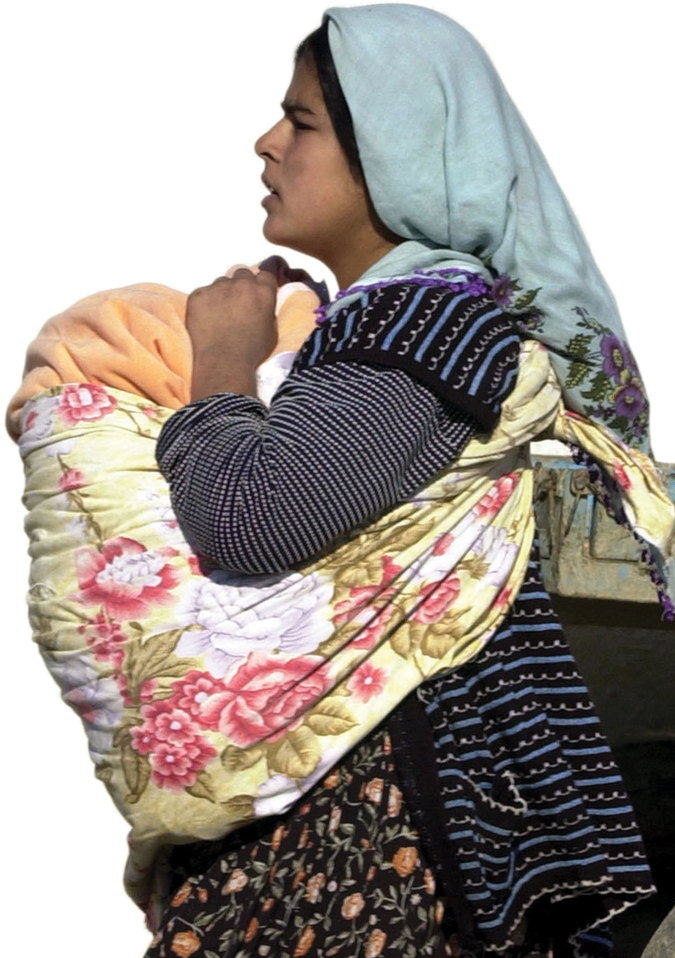
Girls are more likely to be denied education. In 2007, an estimated 101 million children worldwide — the majority of whom were girls — did not attend primary schools (UNICEF, 2010). Africa, the Middle East and South Asia have the largest gender gaps in education. Girls from poor and rural households are especially likely to be denied education. Knowledge and skills needed for employment, empowerment and advancement in status often are withheld because of customary attitudes about educating boys over girls. Girls are more likely to be used as child labor inside and outside of the home. Yet there are many benefits of investing in girls’ education. Healthier families, lower fertility rates, improved economic performance and poverty reduction are among them. Educating girls in a supportive, gender-sensitive environment is critical to achieving gender equality.
The United Nations Population Fund estimates that 100 million to 140 million girls and women have undergone genital mutilation and at least 3 million girls are at risk of the practice every year. Most cases occur in regions of Africa, the Middle East and Asia. In Egypt, it is estimated that 75 percent of girls between 15 and 17 years of age have undergone genital mutilation, a practice which has immediate and long-term negative consequences on girls and women’s health and well-being, and complications can be fatal. Some countries in Africa, Europe and North America have banned genital mutilation; nevertheless, the practice continues.
Child marriage is another human rights violation that occurs in Africa, South and Central Asia and the Middle East. The highest rates are in South Asia and sub-Saharan Africa, where girls are married as early as 7 years of age, but often before 15 or 18 years of age. According to UNICEF statistics, in Bangladesh, the Central African Republic, Chad, Guinea, Mali and Niger more than 60 percent of women married before 18 years of age. In India, 47 percent of women married before 18 years of age. In Yemen, more than 25 percent of girls marry before 15 years of age. Child marriage is a form of sexual abuse that separates girls from family and friends, isolates them socially, restricts education and leaves them vulnerable to violence from husbands and in-laws. Child brides face health risks and even death related to premature forced sex — often with a significantly older husband — and early pregnancies. They are also at increased risk of HIV and other sexually transmitted diseases.
However, grass-roots movements can implement change successfully. An example is the Kembatti Mentti Gezzimma–Tope, spearheaded by Dr. Bogaletch Gebre in Ethiopia to stop genital mutilation. Or the Marriage Without Risk Network in Yemen, which links several NGOs that educate communities and advocate to curb child marriage.
Besides eliminating abuse and discrimination, the Beijing Platform for Action recommends enhanced development and training to improve girl’s status and eliminate their economic exploitation. Awareness of girls’ needs and potential should be improved in society and among the girls themselves so they may participate fully in social, economic and political life. Progress has been made, but much remains to be done to protect girls’ rights and assure them a future in which they may benefit themselves and their communities.
Robin Haarr is a professor of criminal justice at Eastern Kentucky University whose research focuses on violence against women and children and human trafficking, nationally and internationally. She does research and policy work for the United Nations and U.S. embassies and has received several awards for her work, including induction into the Wall of Fame at Michigan State University’s School of Criminal Justice and the Coramae Richey Mann “Inconvenient Woman of the Year” Award from the American Society of Criminology, Division on Women and Crime.
PROFILE: Bogaletch Gebre – Trading New Traditions for Old
By Julia Rosenbaum
Fueled by a dream, Dr. Bogaletch Gebre worked hard with dedication to obtain an education. She became a physician. Ever since, she has worked to empower women in her native Ethiopia, replacing harmful practices with healthy ones — one village at a time.
No mother, no family would intentionally harm their child,” explains Dr. Bogaletch Gebre, founder of the Kembatti Mentti Gezzimma–Tope (KMG), which means “women of Kembatta working together,” a women’s self-help center in southern Ethiopia. Gebre is a champion of women’s development. She has also worked hard to end female genital mutilation, a traditional practice in Africa.
Boge, as she is called, comes from a farming family in Kembatta, southern Ethiopia. Her father protected the weak, widowed and orphaned in their community, giving to those whose harvest was not enough. She describes her mother as a wise, generous and loving woman who believed people do wrong out of ignorance, “because,” their mother told them, “when one wrongs the other, it hurts oneself more than the one who was wronged.” Like all young women of her day, Boge looked forward to her circumcision ceremony, when, she said, “People would start seeing me differently; looking at me in a new and better light.”
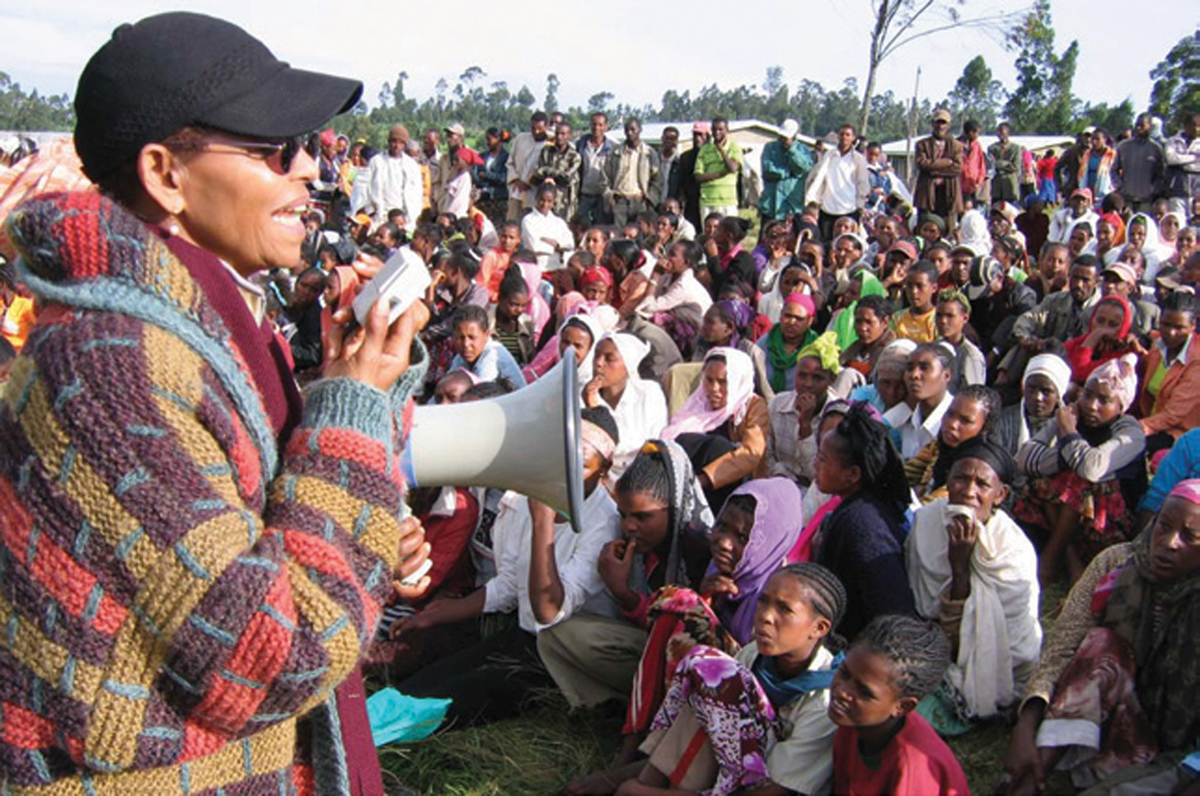
Growing up in a family of 14, she and her younger sister Fikirte were inseparable. They were the first girls in their village to have higher education. Boge attended Hebrew University in Jerusalem on a full scholarship. Later the sisters went to the United States. Boge was a Fulbright Scholar at the University of Massachusetts, where she studied epidemiology and public health. News of the 1984-87 famine in their homeland prompted the sisters to help. Fikirte focused on improving access to clean water for her village. She started a business brewing up tasty sauces and donated part of the profits to her water project. Boge tackled education and livelihood for young women by founding Parents International Ethiopia–Development through Education. She rallied U.S. supporters to end a “book famine” as pervasive as the food famine. She ran fundraising marathons which sent more than 300,000 books on science, medicine and law to Ethiopia.
Boge’s own awakening about genital mutilation grew from the rage and horror over what was done to her as a young woman, what was done to all the girls of her village. “I understood that the purpose of female genital excision was to excise my mind, excise my ability to live my life with all my senses intact,” she said. “I was never meant to be educated, to think for myself, because I am a woman born in a small village in Ethiopia. It’s a system that looks at a woman as an object of servitude. She starts serving her family at the age of 6 — before she even knows who she is. When she marries she is literally sold to the highest bidder. From one servitude to another, we are exploited.”
Boge returned home in 1997 with $5,000 and a vision. With her sister she founded KMG in 1999. The self-help center now includes a skills training center, library, heritage house, a health care center and a guest house and hosts a women’s discussion group. At first they were uncertain about how to realize their vision to break the cycle of violence against women and provide development opportunities.
Boge started with a baseline survey about women’s conditions: health and HIV/AIDS; men’s and women’s education; economic opportunities for women; and female genital mutilation. The results were presented in a community forum where the discussion lit a spark. “Women started speaking out … crying. … Everyone knew the pain and risk of cutting, but perpetuated the practice because they thought it was God-given and was essential if a woman was to be considered marriageable.”
Momentum was building. In June 2002, 78 young schoolgirls marched with placards that read: “I refuse to be circumcised, learn from me.” Two young sweethearts boldly defied tradition, to marry without genital mutilation. They appealed to the local priest, who was already sensitized through KMG outreach. He agreed to support them. At their wedding the bride wore a placard declaring that she was not circumcised, and the groom wore a sign stating his happiness to marry “an uncircumcised, whole girl.” Similar marriages followed, in which couples publicly rejected female genital mutilation. Support groups were formed; there was peer outreach education. “They’ve become our foot soldiers, a social force in their communities,” says Boge. “Girls rally together, singing songs and wearing signs, ‘We are your daughters! Do not harm us.’” A new event introduced in 2004, “Whole Body, Healthy Life — Freedom from Female Genital Excision,” which aims to replace harmful mutilation rituals with life celebrations, has been very well attended. The day is recognized as a freedom day, a new tradition that is celebrated every year.
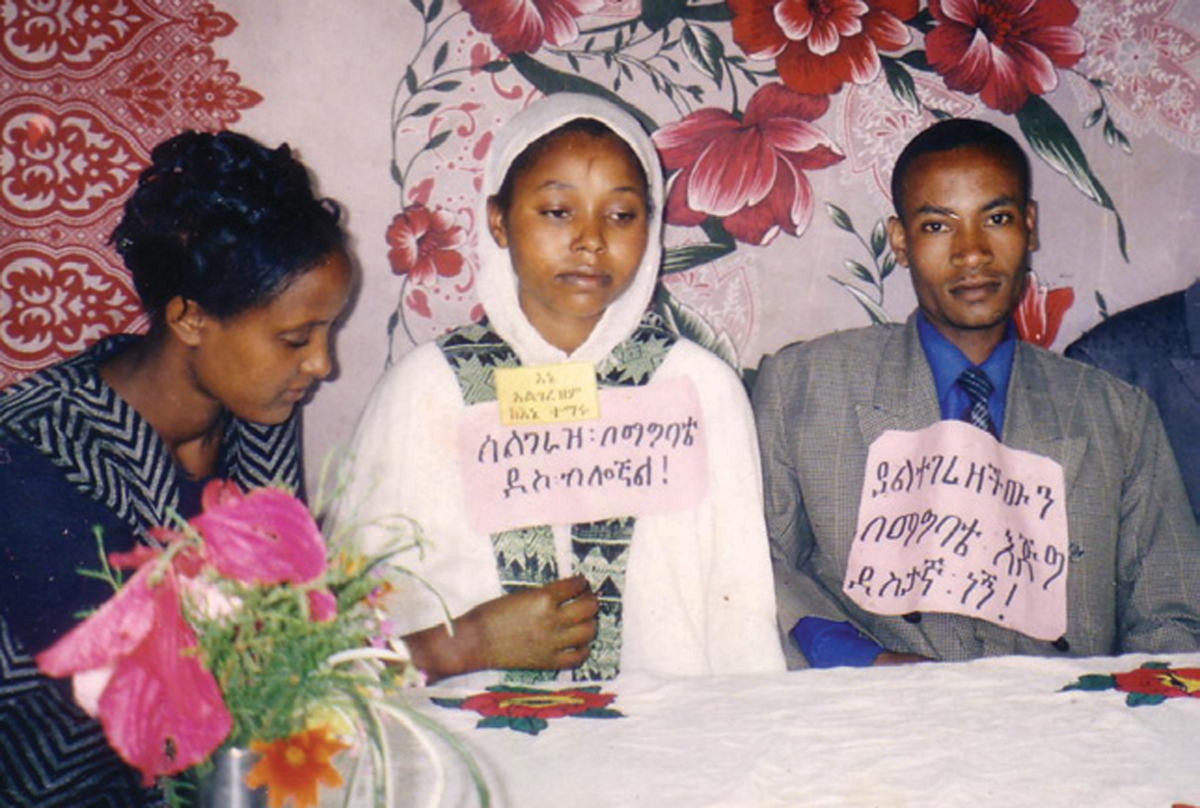
Today, female genital mutilation has been largely eliminated in KMG’s outreach area of 1.5 million people. A 2008 UNICEF study documents the transformation after a decade of intervention in which female circumcision has dramatically decreased to less than 3 percent. This has been accomplished by law and through education of communities about the harm of the practice.
Boge says that support from KMG has helped communities “to trust and unleash their collective wisdom, thereby recognizing their own capacity to effect measurable and sustainable change. We just need to give them the space.”
Community representatives — students and teachers, boys, girls, literate and illiterate, women and men, midwives, religious leaders, and elders — all meet regularly to discuss concerns, build relationships, share learning and reach consensus. Boge says, “Solutions lie within.” KMG facilitates and encourages discussion. “Once they make their commitments, they abide by them.”
It is a holistic approach, Boge says, that recognizes “the indivisibility of social, cultural, economic and political dynamics that affect societies and women in particular … linking ecology, economy and society.” She adds, “In Kembatta, as in other rural regions, social turmoil, environmental degradation and loss of the traditional income base all reinforce attitudes which victimize women and perpetuate violence against women.”
The success of Bogaletch Gebre has meant broader influence of the KMG model in other regions and countries and in policymaking. “We don’t need miracles,” she says. “We need commitment to action, creativity and hard work. And, of course, we need to support each other, as people who share this one world.”
“My dream for African women? That the world realizes that women’s suppression is no good for business, for the economy, nor for human development. We must end gender apartheid,” she says.
Julia Rosenbaum is senior program officer, Health, Population and Nutrition Group, for the Washington-based Academy for Educational Development. She provides technical input and management to global maternal and child health programs. She has worked in Ethiopia for the past six years through USAID’s Hygiene Improvement Project on community-led approaches for hygiene and sanitation improvement and related HIV care and support programs.
PROJECT: Changing Hearts and Minds – Averting Child Marriage in Yemen
By Dalia Al-Eryani and Laurel Lundstrom
Child marriage is one of the biggest threats to young girls in Yemen. It often prevents them from getting an education and following their dreams. It can be devastating physically, psychologically, economically and socially. Local organizations work to improve the prospects of girls by ensuring that they remain unmarried and in school.
She speaks from the heart, like a typical 8-year-old. “I want to be a doctor,” says Arwa (not her real name), revealing a gap in her smile from a missing baby tooth. But her future is not her own.
“I want to work with all sick people,” she quietly insists. “I don’t want to get married at all. I want to stay with my mother.” Despite her dreams, Arwa already understands that the desires of her grandfather will more likely dictate her future.
And her grandfather has different plans. He has already betrothed Arwa to her cousin. Like most child brides, she will not continue with her education. She will be taken from her mother, forced out of school and required to abandon any aspirations of a medical career.
“The greatest problem facing Yemeni women today is child marriages,” says Wafa Ahmad Ali of the Yemeni Women’s Union (YWU), one of several local nongovernmental organizations (NGOs) trying to change the prospects of young girls like Arwa by ensuring they remain unmarried and in school until they are at least 18. The YWU is reaching out to Arwa’s grandfather, hoping he will allow her to live out her dreams. The YWU has helped avert the marriages of 79 children in 2009-2010, through an initiative called the “Safe Age of Marriage” Project.
The YWU works with the Extending Service Delivery Project, which focuses on reproductive health and family planning, and the Basic Health Services Project to transform the opinions of religious leaders, community leaders and families to value girls’ education over early marriage. It’s not an easy task. The YWU faces resistance from community members who think the organization is “meddling with local norms and traditions,” says Wafa Ali. Poverty and conservative views about the role of women are also problems.
Coordinators from the YWU oversee a team of 40 volunteer community educators — 20 men and 20 women — concentrated in Amran governorate’s Al Sawd and Al Soodah districts, where 59 percent of families marry off their daughters before the age of 18. The governorate’s capital city, Amran, an ancient trading center, is located about 50 kilometers north of Yemen’s capital, Sana’a. Only 1 percent of women in Amran governorate have attended school, according to a baseline assessment conducted by the Safe Age of Marriage Project.

The volunteers raise awareness about the social and health consequences of child marriage through lively discussions, film screenings, plays, writing competitions, poetry readings, debates and literacy classes. One of their main lessons is about the healthy timing and spacing of pregnancy. The messages about family planning are tailored to be appropriate for Islamic communities, and encourage girls not to get pregnant for the first time until they are at least 18.
Safia, one of YWU’s community educators, frequently hears about the consequences of child marriage and early pregnancy. “My 16-year-old daughter is cursed,” says a woman at one of Safia’s sessions. She adds that each time the girl has tried to bring a new life into the world, she has failed. “The babies always die,” she says. “But my 20-year-old daughter, she is not cursed. She has healthy babies.” Safia advised the woman that because her daughter had married early, she and her babies were at an increased risk of death. The mother’s reaction: “My daughter isn’t cursed after all!”
By delaying marriage, the project aims to slow maternal, newborn and infant deaths and associated conditions such as obstetric fistula, childhood deformities, mental illness, depression and domestic violence. Other organizations around the country with similar goals include the Marriage Without Risks Network, a group of five local NGOs funded by the Middle East Partnership Initiative. Each NGO approaches child marriage from a different angle: some focus on grass-roots awareness campaigns, classroom workshops or media campaigns; others conduct studies to determine the prevalence and effects of early marriage on girls and their families; and others advocate for change by engaging decisionmakers such as parliamentarians and religious leaders. The network outreach allows the groups to connect with other like-minded organizations throughout Yemen, from international organizations to community groups to Islamic foundations, that work to eliminate child marriage. By sharing successful approaches, members of the network enhance its effectiveness.
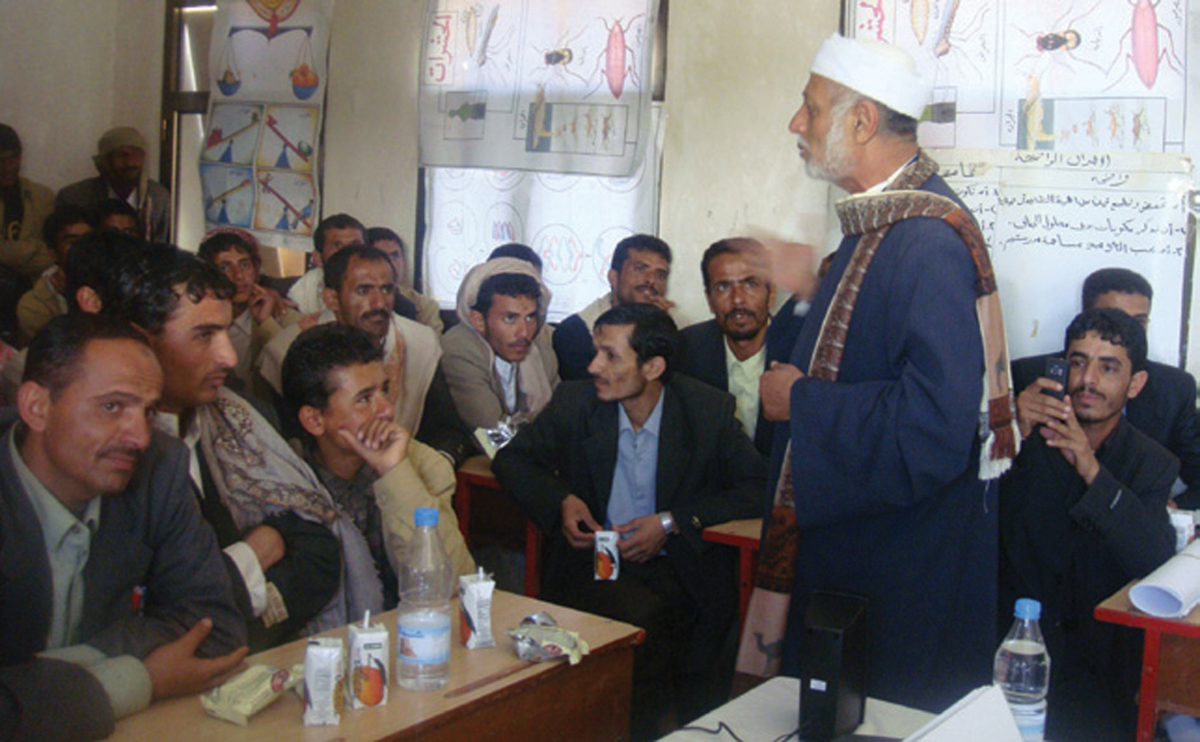
Cooperation of men in the community is essential. Here Sheikh Yahya Ahmed Abdulrahman Al-Naggar engages other Yemeni religious leaders and men as he sensitizes them to the importance of reproductive health and family planning.
“Fistula!” shouts a young girl in response to a question about the health risks of early marriage. The girl, who wears a white scarf, speaks confidently to the audience, describing how this injury, caused by complications during childbirth, can ruin a woman’s life. Girls whose bodies are not fully developed are particularly at risk for fistula. Community educators explain such risks to impress upon the girls and their families the importance of marriage at a safe age.
By attending a similar session, Ali, another community member, changed from being an advocate for child marriage into a strong advocate for delaying marriage. In fact, when he met a father whose daughter, at age 13, was about to be married, he argued so passionately to stop the marriage that he convinced the father to break off the engagement — and he paid the father back part of the dowry already sacrificed to the groom-to-be. There was no wedding, and the daughter is back in school.
The Safe Age of Marriage Project has reached nearly 41,000 people, and child marriage for girls between 10 and 17 has decreased in both districts. In Al Soodah, the community is trying to pass a local law dictating a “safe age of marriage.”
The intervention is now being spread to two neighboring districts, with plans to expand it nationally in the future.
Ali says that the YWU will spread the intervention to seven to eight more governorates. “Part of the strategic plan for the YWU is to do advocacy with local authorities and decisionmakers and ask them to take measures to guarantee girls get married at a safe age,” he says.
Dalia Al-Eryani is the project coordinator of the Safe Age of Marriage Project in Yemen, which educates communities on the risks of early marriage. A Fulbright Fellow, she works with Yemen’s Basic Health Services Project.
Laurel Lundstrom served as the communications officer for the Extending Service Delivery Project, USAID’s flagship reproductive health and family planning project. She has written for the United Nations, Global Health magazine and the World Health Organization, and co-produced a short documentary on maternal and newborn health in Yemen.
Multiple Choice Questions
Questions
- Perceptions that lead to a preference for sons include:
- Daughters are an economic burden on the family
- Daughters do not contribute to family income
- Girls are less likely to receive proteins and nutrients necessary for growth and development
- Girls are more likely to be denied education
- All of the above
- According to the chapter, many girls in South Asia and Sub-Saharan Africa are married…
- As young as 7 years old, but often below 15 – 18 years
- Between 10 – 15 years
- Between 20 – 22 years
- Between 10 – 20 years
- None of the above
- According to the text, what percentage of girls in Egypt have undergone FGM?
- 20%
- 80%
- 75%
- 5 – 10%
- None of the above
- Which factors reinforces attitudes which perpetuate violence against women and girls?
- Social turmoil
- Environmental degradation
- Loss of traditional income
- All of the above
- Bogaletch Gebre’s dream for African women is…
- That societies value all genders equally
- That people realize that suppression of women is bad for business, the economy, and human development
- That women are paid the same as men and achieve full political and economic participation
- All of the above
- None of the above
- According to the chapter, the YWU has received resistance on what basis?
- The organization is meddling with local traditions
- The medical concerns of early marriages are unfounded
- Girls and families are unharmed by early marriages
- The emotional impact on girls is not a concern
- None of the above
- The YWU engages in which activities to raise awareness of the harms of early marriage?
- Discussions
- Film screenings
- Writing competitions
- Poetry readings
- All of the above
Answers
- The correct answers are A and B. The perceptions that lead to a preference for sons over daughters are that daughters are an economic burden on the family and do not contribute to family income. Answers C and D are both forms of discrimination against girls, not perceptions of daughters.
- The correct answer is A (as young as 7 years old, but often below 15 – 18 years).
- The correct answer is C (75 percent).
- The correct answer is d. (all of the above).
- The correct answer is for people to realize that suppression of women is bad for business, the economy, and human development (answer B).
- The correct answer is A (that the organization is meddling with local traditions by working to stop early childhood marriage). While there may be individual proponents of early and child marriage that believe the medical concerns of the practice are unfounded (answer B), that girls and families are unharmed by early marriages (answer C), and that the emotional impact on girls is not a concern (answer D), these objections were not mentioned in the text.
- The correct answer is E (all of the above).
Discussion Quetsions
- How are the risks of early and child marriage represented in the Millennium Development Goals (MDGs)? What about the Sustainable Development Goals (SDGs)? What progress has the international community made in reducing this practice?
- What types of programs are discussed in the chapter that aim to prevent early and child marriage? Are they effective? Why or why not?
- Why should combatting child marriage be a priority for governments and the international community?
- What are the economic, social, and institutional root causes that lead to rights violations against girls, such as child marriage?
- Reviewing both the chapter and additional resources provided, consider how the perspective given on FGM in the chapter contrasts with the perspective given by Lisa Wade in her article.
- Why does early/child marriage happen in states where it is illegal? What are the ways in which a robust nation-state and civil society can counteract such practices?
Essay Questions
- Why should child marriage and FGM be concerns of the U.S. government when these practices are largely happening on separate continents? More broadly, what should be the role of the United States in intervening in the familial customs of sovereign countries?
- Review the post-colonial critiques of the anti-FGM movement provided in the additional resources section. How can one address the practice of FGM in a way that is consistent with these critiques?
- Discuss the role that culture and religion determine in setting one’s values in relation to female genital mutilation and early/child marriage, as well as in forming policies to address them.
- What is the relationship between economics, poverty, and child marriage? Assuming that poverty and child marriage are linked, is it more effective to stop child marriage itself or to address the poverty that surrounds the practice?
Additional Resources
Al-Jazeera. “Too Young to Marry: Child Marriage in Bangladesh.”
Documentary on the illegal practice of child marriage in Bangladesh.
Blackstock, C. “Jordan & Shannen: First Nations Children Demand that the Canadian Government Stop Racially Discriminating Against Them.” First Nations Child and Family Caring Society of Canada. 2011.
Shadow Report to the Committee on the Rights of the Child on Canada’s implementation of the convention in the context of services for Indigenous children.
https://fncaringsociety.com/publications-and-resources
Frohmader, C. “The Sexual and Reproductive Rights of Women and Girls with Disabilities.” International Conference on Human Rights.” (2014).
Examines sexual and reproductive rights of women and girls with disabilities as it relates to the post-2015 development agenda.
Nirantar Trust. “Early and Child Marriage in India: A Landscape Analysis.” Nirantar Trust.
Comprehensive report on the root causes of child marriage in India, including the compounding of patriarchy, class, caste, religion and sexuality.
Santhya, K. G. & Jejeebhoy, S. “Sexual and Reproductive Health and Rights of Adolescent Girls: Evidence from Low and Middle-Income Countries.” Global Public Health 10(15), 189 – 221: (2015).
Proposes increased sexual education, health services, and safe spaces programs for vulnerable girls.
http://www.tandfonline.com/doi/full/10.1080/17441692.2014.986169
UNICEF. “Child Friendly Resources.” UN Convention on the Rights of the Child in Child Friendly Language.
Accessible version of the rights contained within the UNCRC.
http://www.unicef.org/rightsite/484_540.htm
UNICEF Jordan. “A Study on Early Marriage in Jordan 2014.” (2014).
Findings of a qualitative and quantitative study on early marriages in Jordan, as well as Palestinians and Syrian communities within the country in the wake of the Syrian civil war and resulting refugee crisis.
http://www.unicef.org/mena/UNICEFJordan_EarlyMarriageStudy2014(1).pdf
Wade, L. “The Trouble with American Views of Female Genital Cutting.” Sociological Images. (2015).
Critique of American discourse on Female Genital Cutting, which suggests that it has alienated the women it seeks to support.

